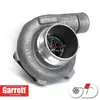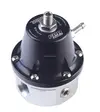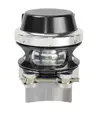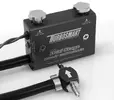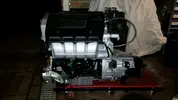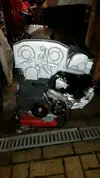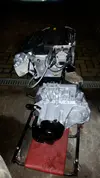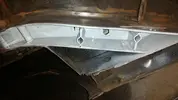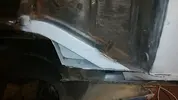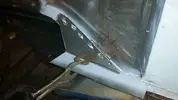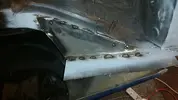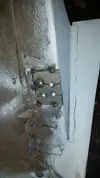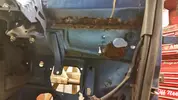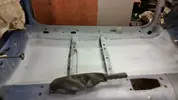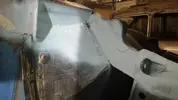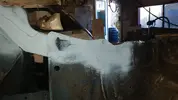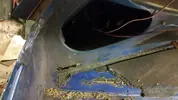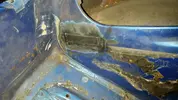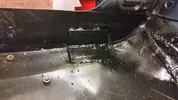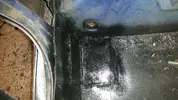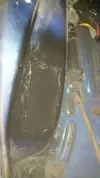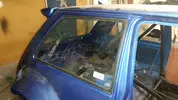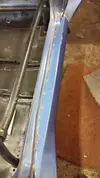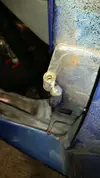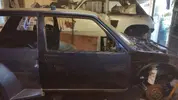Brucieboy
Active Member
After seeing the rot it was time to dig in and start cleaning it up where surface and removing completely where it had set in.
Hours and hours passed with 9" angle grinder with wire wheel fitted and 4 1/2" grinder with cutting wheel fitted to open it all out to expose the insides to see if it had gone in all the way.
![20151231_143041[1].webp 20151231_143041[1].webp](https://turborenault.co.uk/data/attachments/11/11182-0f7b874c74b8577f476392b6f19b5b1a.jpg?hash=gCIL19A5jF)
Axle mounting points are made up of the main chassis leg and a second strengthening plate over the top where it actually bolts through. Templates are required for the replacement plates so we got to work. All panels were removed by drilling out spot welds and taking off layer by layer for the multiple thicknesses.
![20160104_182938[1].webp 20160104_182938[1].webp](https://turborenault.co.uk/data/attachments/11/11183-57fa11c18454ca6638444368e6a3e5be.jpg?hash=48OL2UoSmk)
Note the locating inserts for the axle mounting bolts. These act as a datum point for the repairs and gladly only minor surface rust was discovered once top layer was removed.
![20160104_182944[1].webp 20160104_182944[1].webp](https://turborenault.co.uk/data/attachments/11/11184-199e006af2880ad171cea2dab7ca5acc.jpg?hash=wI9M8l1Hvi)
Inner sills were so bad we replaced them. Completely on drivers side and half way on passenger side as it was only the bottom inch or two that was rotted.
![20160104_182948[1].webp 20160104_182948[1].webp](https://turborenault.co.uk/data/attachments/11/11185-4b50319dff97a6d3495dd6b36549ec76.jpg?hash=pS21s_0JbI)
![20151221_164539[1].webp 20151221_164539[1].webp](https://turborenault.co.uk/data/attachments/11/11186-0f6adf11682b45335526cce4634ae670.jpg?hash=9D0ucNeB2Q)
Care was taken to ensure points like the seatbelt mounting block were replaced correctly and cross members were attached in exactly the same place.
![20151221_154600[1].webp 20151221_154600[1].webp](https://turborenault.co.uk/data/attachments/11/11187-fa8ac361679ba575d8528150ca78e0cc.jpg?hash=4lfwwNOqZT)
Out with the old and in with the new. Whoop Whoop!
Hours and hours passed with 9" angle grinder with wire wheel fitted and 4 1/2" grinder with cutting wheel fitted to open it all out to expose the insides to see if it had gone in all the way.
![20151231_143041[1].webp 20151231_143041[1].webp](https://turborenault.co.uk/data/attachments/11/11182-0f7b874c74b8577f476392b6f19b5b1a.jpg?hash=gCIL19A5jF)
Axle mounting points are made up of the main chassis leg and a second strengthening plate over the top where it actually bolts through. Templates are required for the replacement plates so we got to work. All panels were removed by drilling out spot welds and taking off layer by layer for the multiple thicknesses.
![20160104_182938[1].webp 20160104_182938[1].webp](https://turborenault.co.uk/data/attachments/11/11183-57fa11c18454ca6638444368e6a3e5be.jpg?hash=48OL2UoSmk)
Note the locating inserts for the axle mounting bolts. These act as a datum point for the repairs and gladly only minor surface rust was discovered once top layer was removed.
![20160104_182944[1].webp 20160104_182944[1].webp](https://turborenault.co.uk/data/attachments/11/11184-199e006af2880ad171cea2dab7ca5acc.jpg?hash=wI9M8l1Hvi)
Inner sills were so bad we replaced them. Completely on drivers side and half way on passenger side as it was only the bottom inch or two that was rotted.
![20160104_182948[1].webp 20160104_182948[1].webp](https://turborenault.co.uk/data/attachments/11/11185-4b50319dff97a6d3495dd6b36549ec76.jpg?hash=pS21s_0JbI)
![20151221_164539[1].webp 20151221_164539[1].webp](https://turborenault.co.uk/data/attachments/11/11186-0f6adf11682b45335526cce4634ae670.jpg?hash=9D0ucNeB2Q)
Care was taken to ensure points like the seatbelt mounting block were replaced correctly and cross members were attached in exactly the same place.
![20151221_154600[1].webp 20151221_154600[1].webp](https://turborenault.co.uk/data/attachments/11/11187-fa8ac361679ba575d8528150ca78e0cc.jpg?hash=4lfwwNOqZT)
Out with the old and in with the new. Whoop Whoop!


![20151229_154324[1].webp 20151229_154324[1].webp](https://turborenault.co.uk/data/attachments/11/11188-8573009b7e0a6f2f186bfac8489218a4.jpg?hash=hjWf6FkgQC)
![20151231_143049[1].webp 20151231_143049[1].webp](https://turborenault.co.uk/data/attachments/11/11191-fa98269706f382aaaa06dadb50252349.jpg?hash=EiHIwniJwD)
![20160107_182013[1].webp 20160107_182013[1].webp](https://turborenault.co.uk/data/attachments/11/11192-55d72a007068ca19275f57ab25d54716.jpg?hash=js6t19eYtq)
![20160107_205352[1].webp 20160107_205352[1].webp](https://turborenault.co.uk/data/attachments/11/11193-b777d7e45c50a0618143f8746ca7d1ee.jpg?hash=iu2TXs8UbC)
![20160109_141531[1].webp 20160109_141531[1].webp](https://turborenault.co.uk/data/attachments/11/11194-2a9f60c711da09e340cc07e20a48b979.jpg?hash=8Xu9rNlfP4)
![20160109_155026[1].webp 20160109_155026[1].webp](https://turborenault.co.uk/data/attachments/11/11195-cf9e0b37824b5f79a1cad7a65eb14dc6.jpg?hash=uKnDbTpjTR)
![20160109_174517[1].webp 20160109_174517[1].webp](https://turborenault.co.uk/data/attachments/11/11196-6ec5afabda34630e496887a2d8eb4c55.jpg?hash=b0I72P9YmY)
